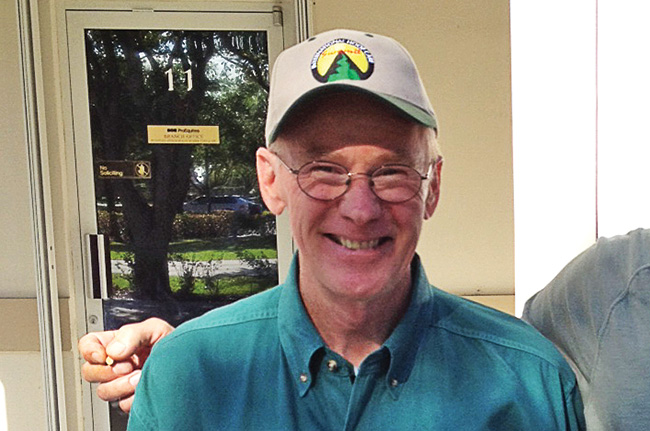 Glue and composite shoeing isn’t for every chronically laminitic horse, but it can be a valuable tool that can help some.
Glue and composite shoeing isn’t for every chronically laminitic horse, but it can be a valuable tool that can help some.
In her presentation titled, “Alternative Approach In Rehabilitating The Chronically Laminitic Foot Using Composite Materials,” Parkesburg, Pa., farrier Daisy Bicking says she employs glue or composites when she’s unable to safely or effectively nail a shoe on a foot, the hoof wall quality is poor or to prevent discomfort when nailing.
“The benefits of building a prosthetic foot for a horse is it gives you the ability to push the trim and replace damaged or missing material,” she told attendees at the 13th annual International Hoof-Care Summit in Cincinnati, Ohio. “Glue and composite are easily modified for wedging, building height, easing breakover and creating mechanics. You are only limited by your own creativity with these materials.”
There are two critical considerations when using these materials.
“Chronically laminitic horses need frog support,” Bicking says, “and a wide web to help share the load.”
Eliminating Mistakes And Misconceptions That Damage The Use Of Adhesives
A trio of farriers teamed up to discuss a variety of tips and myths about using adhesives in shoe application.
Cornell University’s head farrier Steve Kraus, University of Pennsylvania’s head farrier Patrick Reilly and Wellington, Fla., farrier Curtis Burns extensively use adhesives in their work.
“Are adhesives safe?” Reilly asks rhetorically. “Yes, for the most part they are. You want to use a little common sense, though. You want to use them in a well-ventilated area and avoid direct contact with skin. I can tell you what it tastes like, but that wasn’t on purpose. I pulled some gloves off with my teeth.”
Some claim also claim that adhesives damage hoof wall, but Kraus disputes that notion.
“What ruins hoof wall,” says the Hall Of Fame farrier, “is improper removal of the application that has been glued to the foot.”
Shoeing Based On Disciplines And Different Footings
Riding surfaces affect the performance and shoeing needs of the equine athlete. Interacting with the surface is influenced by the horse’s conformation, which in turn influences the forces applied to the foot and consequently limb loading, Lexington, Ky., farrier and veterinarian says during the Better Practices, Better Results Lecture, presented by Kinetic Vet.
“The composition of the surface and the interaction with the foot,” he says, “coupled with the physical demands of the horse determine the proper shoeing protocol.”
There’s a catch-22, though.
“The surface with optimal performance — a hard, fast footing — is associated with a greater risk of injury,” Dryden says. “That’s makes sense. The optimum surface minimizes concussion through energy absorption and returns suitable power to aid performance.”
Shoeing The Hind Limb For Performance And Therapy, Part 2
Cortona, Italy, farrier and veterinarian Hans Castelijns discussed a number of points as he continued his presentation on the hind limbs.
“The consequences of compensatory laminitis in the hind legs seem higher,” the Hall Of Fame vet says. “The horse needs to alternate weight-bearing in the hinds regularly.
Castelijns also presented his uniform trimming protocol for hind feet, which advocates leaving what belongs to the foot and trimming away the excess.
In Closing
 Concluding the 13th annual International Hoof-Care Summit, Columbia, Mo., equine veterinarian Amy Rucker rallied attendees to take home the knowledge they gathered over the past 4 days.
Concluding the 13th annual International Hoof-Care Summit, Columbia, Mo., equine veterinarian Amy Rucker rallied attendees to take home the knowledge they gathered over the past 4 days.
“If you’re anything like me, when you leave here you will be eager to put all of your new knowledge to work,” the Hall Of Fame veterinarian says. “When you go home to try something new that you learned here, leave hoof mass. Don’t throw the baby out with the bath water.”
Often, the Summit is not only an opportunity to expand footcare knowledge, but to forge bonds with colleagues around the country.
“One thing I always take home,” Rucker says, “is my friendships.”
Life is unpredictable, though, and there are times when our mortality comes into sharp focus. Rucker turned her thoughts to the passing of Hall Of Fame farrier and American Farriers Journal Technical Editor Red Renchin, who passed away late last summer.
“If anyone should have named after him, it’s Red,” she says, referring to the Robert “Red” Renchin Distinguished Leadership Award that was inaugurated at this year’s Summit. “My biggest takeway is — be like Red. He had the highest level of integrity and enthusiasm. When I would see Red, he would light up and say, ‘Amy!’ He made me feel like one of his best friends.”
Rucker issued a challenge to all the attendees.
“If we could greet our clients that way and make them feel the way Red did, think of the effect that would have,” she says. “I think that’s the best tribute to him. Be like Red for a year and the world would be a better place.”







